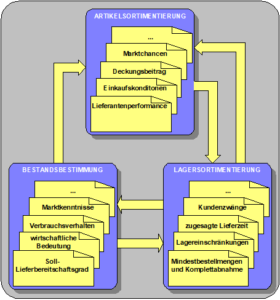Article and stock sorting
from A. Klüttgen1
The fact that the seller’s market is changing into a buyer’s market is nothing new. However, many companies do not seem to be able to cope with the speed at which this transformation process is taking place. The customer demands the “business now”. A comprehensive selection of articles, quality and competitive prices are taken for granted. They are indispensable article characteristics in the wake of the core requirement of the buyer’s market, namely unrestricted readiness to deliver.
The structure of complexity
In the absence of suitable planning tools and often also the necessary know-how, complex article and stock ranges are built up in response to the increased demands of the market. The goal of customer loyalty through a large selection leads to product ranges with a large breadth. In addition, the depth of the range is being expanded by offering a large number of variants of individual products. This complexity leads to a sensitive and permanent impairment of the earnings situation wherever it is not necessary in terms of contribution margin calculations or marketing. Inefficiencies at all stages of the supply chain (procurement, production, warehousing, sales, after-sales service) are the result. This leads directly to the demand for a reduction in complexity. In this environment of uncertainty, the term “anxiety stocks” is bandied about – familiar to everyone, yet not openly discussed!
The three-stage decision-making process
In order to avoid the earnings trap caused by product range complexity, it is important to streamline and design the product and stock range as part of an iterative decision-making process (see Figure 1):
- What is the composition of the product range on offer?
- Which items in this range should be stored and which should not?
- What is the optimum stock level for the items to be stored?
At the end of the third phase, it may be necessary to correct the decisions made previously. For example, the optimum stock level, which depends on the degree of readiness for delivery, can lead to the retrospective decision not to stock a product after all if the inventory costs are too high.
The first and at the same time most comprehensive stage of the decision-making process shapes the scope of action for the two subsequent stages. For products that were already part of the product range, it is essential to determine their economic importance and consumption behavior by means of a classification according to ABC / XYZ analysis. The findings obtained in this way, such as the extent to which an article has contributed to commercial success and how regularly it was consumed and in what quantities, must then be supplemented by influences such as trend, season, promotions, structural breaks and the article-specific life cycle stage. The recurring classification according to ABC and XYZ always means the recurring assessment of the product range. This allows conclusions to be drawn about where to focus article-related efforts. The analysis of an internationally active production company should serve as an example here: Only 20% of the items analyzed showed any consumption at all over a 12-month period. Of these items, only around 20% fell into the AX, BX, AY or BY categories (A and B: high turnover, X and Y: regular consumption, easily predictable). These articles accounted for 73% of the sales achieved. Only 5% of sales were accounted for by so-called C articles, although these made up 60% of articles with consumption. This revealed a dramatic disparity between the planning and administrative effort on the one hand and the profitability of these articles on the other. However, other aspects must be taken into account when deciding whether to keep a product in the product range or even add it to the range. For example, the following questions arise:
- How good is the supplier performance? How can purchasing conditions be structured?
- What impact does a product have on manufacturing processes, capacities and resources?
- What chances does the product have on the market? Can opportunities be increased through the use of sales instruments? Are there product features that complement the range, e.g. as an alternative purchase?
- Is a C product attractive because it delivers a high contribution margin?
- Is the timely elimination of low-profit products accompanied by the offer of new products in the long-term assessment?
- Is a new product a market novelty or “only” a company novelty? Are there production interdependencies (e.g. joint production)?
It is interesting to note that at this stage of product range design, the issues at hand are often declared a matter for the boss, although product management is responsible for managing the range and the product and market knowledge can also be found there and in sales.
Once the composition of the range of articles has been determined, the question of whether or not to store articles must be answered. At this point, in addition to the planning and administrative effort involved, the storage costs come to the fore as a massive profit-reducing component. Based on the above example, 25% of stock was accounted for by Z and Z2 items (Z: sporadic with strongly fluctuating quantities, Z2: consumed in less than half of the months; limited or no predictability). An even larger proportion of the stock was found in products that had not been used at all for at least 12 months. This raises the question of the reason for storage, the costs of which can amount to around 20% or more of the average stock stored per year. In addition to the pure analysis, other aspects must also be taken into account in this phase, e.g:
- Are there guaranteed periods for subsequent deliveries?
- Are there customer constraints (the important customer for whom there is always stock)?
- Is the delivery time promised to the customer shorter than the company’s own replacement time or lead time for in-house production or assembly?
- Are delivery time catalogs, minimum order quantities, complete purchase obligation and other things enforceable?
- What storage restrictions and limitations exist (e.g. warehouse design or storage of hazardous substances)?
The next step is to determine the optimum stock levels for the warehouse items. Here, distribution-free methods can be used to determine the stocks that represent the minimum on average for a given target readiness to deliver, e.g. 98%. Here, too, further information must be included in addition to the pure analysis. In particular, market knowledge, which can be gathered primarily in sales and customer service, must be incorporated into sales planning and product range design in good time.
Aims of the product range design
The main objective of product range design is to satisfy customer needs and stand out from the competition while maintaining profitability. Adherence to the principle of economic efficiency results in the sub-goals of reducing inventories while achieving a specified delivery readiness, improving the flow of goods, reducing the administrative and planning burden on the supply chain and sustainably strengthening profitability. When streamlining product ranges in particular, it is important to ensure that the cost savings more than compensate for the loss of sales. Although this requirement sounds self-evident, practice shows that it cannot always be met. This is due to the fact that companies are often unable to determine the administrative and warehousing costs of a product due to deficiencies in data quality. As a result, the comparison of the cost reduction with the loss of sales can often only produce an estimated or approximate result.

1Armin Klüttgen is a consultant at Abels & Kemmner GmbH

